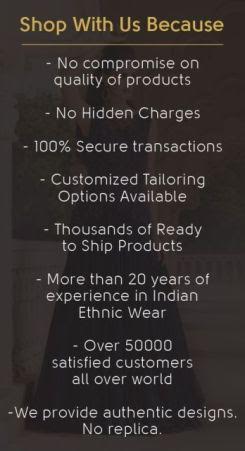
Introduction to Designer Kurtis
When it comes to Indian ethnic wear, designer kurtis have gained immense popularity among women. These stylish and versatile garments offer a perfect blend of tradition and contemporary fashion. Designer kurtis are not only comfortable to wear but also exude elegance and grace. They are perfect for various occasions, be it a casual outing, a formal event, or a festive celebration. Aishwarya Design Studio is a leading brand that offers a wide range of designer kurtis that can elevate your style and make you stand out in the crowd.
Benefits of Wearing Designer Kurtis
There are numerous benefits to wearing designer kurtis, especially for women. Firstly, designer kurtis are available in a wide range of styles, patterns, and colors, allowing women to express their individuality and personal style. Whether you prefer a traditional look or a contemporary one, there is a designer kurti for every taste.
Secondly, designer kurtis are incredibly versatile and can be paired with various bottoms like leggings, palazzo pants, or even jeans. This versatility makes them suitable for different occasions and events. You can dress them up or down depending on the occasion and your personal style.
Lastly, designer kurtis are known for their comfort. The breathable and lightweight fabrics used in their construction make them ideal for the hot and humid Indian weather. You can stay comfortable and stylish all day long without compromising on your fashion choices.
Different Styles of Designer Kurtis
Designer kurtis come in a plethora of styles, ensuring that there is something for everyone. Some of the popular styles include:
-
Anarkali Kurtis: These kurtis are known for their flared silhouette and are perfect for festive occasions. They usually feature intricate embroidery or embellishments.
-
Straight-Cut Kurtis: As the name suggests, these kurtis have a straight cut and are suitable for both casual and formal wear. They can be paired with leggings or jeans for a contemporary look.
-
A-Line Kurtis: A-line kurtis have a fitted bodice that gradually flares out towards the hem, forming an 'A' shape. They are flattering for all body types and can be worn for various occasions.
-
High-Low Kurtis: These kurtis have a hemline that is shorter in the front and longer at the back, creating a trendy and fashionable look. They can be paired with leggings or palazzo pants.
-
Jacket Style Kurtis: Jacket style kurtis feature an attached jacket-like layer over the kurti, adding a touch of sophistication and elegance. They are perfect for formal events and parties.
Factors to Consider When Buying Designer Kurtis
When purchasing designer kurtis, there are a few factors to consider to ensure that you make the right choice:
-
Fabric: The fabric of the kurti plays a crucial role in its overall comfort and appearance. Opt for fabrics like cotton, silk, or chiffon, depending on the occasion and personal preference.
-
Size and Fit: It is essential to choose a kurti that fits you well. Consider your body type and measurements while selecting the size. An ill-fitting kurti can ruin the entire look.
-
Embellishments and Embroidery: Designer kurtis often come with intricate embellishments and embroidery. Pay attention to the quality and craftsmanship of these details as they can significantly enhance the overall look of the garment.
-
Occasion: Consider the occasion or event for which you are purchasing the kurti. Opt for a more elaborate design for festive occasions and a simpler one for casual wear.
-
Budget: Set a budget before shopping for designer kurtis. Aishwarya Design Studio offers a wide range of kurtis at different price points, ensuring that there is something for every budget.
Aishwarya Design Studio - A Leading Brand for Designer Kurtis
Aishwarya Design Studio is a renowned brand that specializes in designer kurtis for women. With their commitment to quality, craftsmanship, and unique designs, they have established themselves as a leading name in the industry. Their extensive collection of designer kurtis caters to a wide range of tastes and preferences.
Aishwarya Design Studio focuses on creating garments that are not only fashionable but also comfortable. They use high-quality fabrics and pay attention to every detail to ensure that their kurtis are of the highest standard. Whether you are looking for traditional Indian kurtis or contemporary designs, you can find it all at Aishwarya Design Studio.
Popular Designer Kurtis for Women
Aishwarya Design Studio offers a wide variety of designer kurtis for women. Here are some popular options available:
-
Embroidered Kurtis: These kurtis feature intricate embroidery work, adding a touch of elegance and charm. They are perfect for festive occasions and weddings.
-
Printed Kurtis: Printed kurtis come in a range of vibrant and eye-catching prints, making them suitable for casual wear. They can be paired with leggings or jeans for a stylish look.
-
Block Print Kurtis: Block print kurtis are known for their unique and traditional designs. They are perfect for those who appreciate the artistry and craftsmanship of hand block printing.
-
Georgette Kurtis: Georgette kurtis are lightweight and flowy, making them perfect for summer wear. They are comfortable and offer a trendy and fashionable look.
-
Silk Kurtis: Silk kurtis exude elegance and sophistication. They are perfect for formal occasions and parties, adding a touch of glamour to your ensemble.
Styling Tips for Wearing Designer Kurtis
To make the most of your designer kurtis, here are some styling tips to keep in mind:
-
Pair your designer kurti with leggings for a casual and comfortable look. Opt for contrasting colors to create a visually appealing outfit.
-
Accessorize your kurti with statement jewelry like earrings, bangles, or a necklace to elevate your look. Choose accessories that complement the colors and style of your kurti.
-
Experiment with different bottom options like palazzo pants or jeans to create a contemporary and chic look. Mix and match to create unique and stylish ensembles.
-
For a more traditional look, pair your kurti with a matching or contrasting dupatta. This adds a touch of elegance and completes the overall outfit.
-
Don't forget to wear the right footwear to complement your kurti. Opt for heels or flats depending on the occasion and your personal style.
How to Care for Your Designer Kurtis
To ensure that your designer kurtis last long and look their best, follow these care tips:
-
Always check the care instructions provided by the manufacturer. Different fabrics may require different washing and care methods.
-
Handwash your designer kurtis using a mild detergent. Avoid using harsh chemicals or bleach as they can damage the fabric.
-
Gently squeeze out excess water from the kurti and dry it in the shade. Avoid direct sunlight as it can cause the colors to fade.
-
Iron your kurti on a low heat setting to remove any wrinkles. Be careful while ironing delicate fabrics like silk to prevent any damage.
-
Store your designer kurtis in a cool and dry place to avoid any moisture or insect damage. Use hangers or fold them neatly to prevent any creases.
Where to Buy Designer Kurtis
Aishwarya Design Studio is the go-to destination for women's designer kurtis. They offer a seamless online shopping experience, allowing you to browse through their extensive collection and choose the perfect kurti from the comfort of your home. Their website is user-friendly, making it easy to navigate and find your desired kurti.
Visit Aishwarya Design Studio's website today and explore their collection of designer kurtis to elevate your style and make a fashion statement.
Conclusion
Designer kurtis from Aishwarya Design Studio offer the perfect blend of style, comfort, and elegance. With their wide range of designs, patterns, and colors, there is a kurti for every occasion and personal style. Whether you are attending a wedding, a casual outing, or a festive celebration, designer kurtis can elevate your style and make you stand out in the crowd. So, embrace the beauty of Indian ethnic wear and add a touch of sophistication to your wardrobe with designer kurtis from Aishwarya Design Studio - https://www.aishwaryadesignstudio.com/kurtis


 +1 323 315 2595
+1 323 315 2595  +44 11621 61404
+44 11621 61404 
 shopping bag
shopping bag















